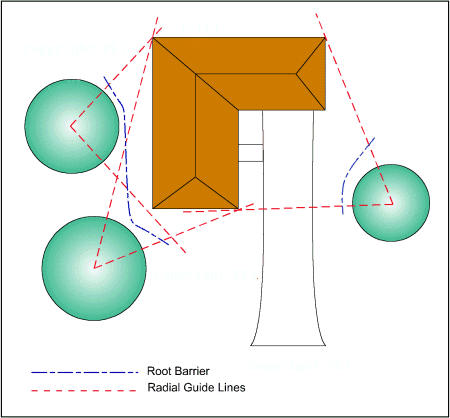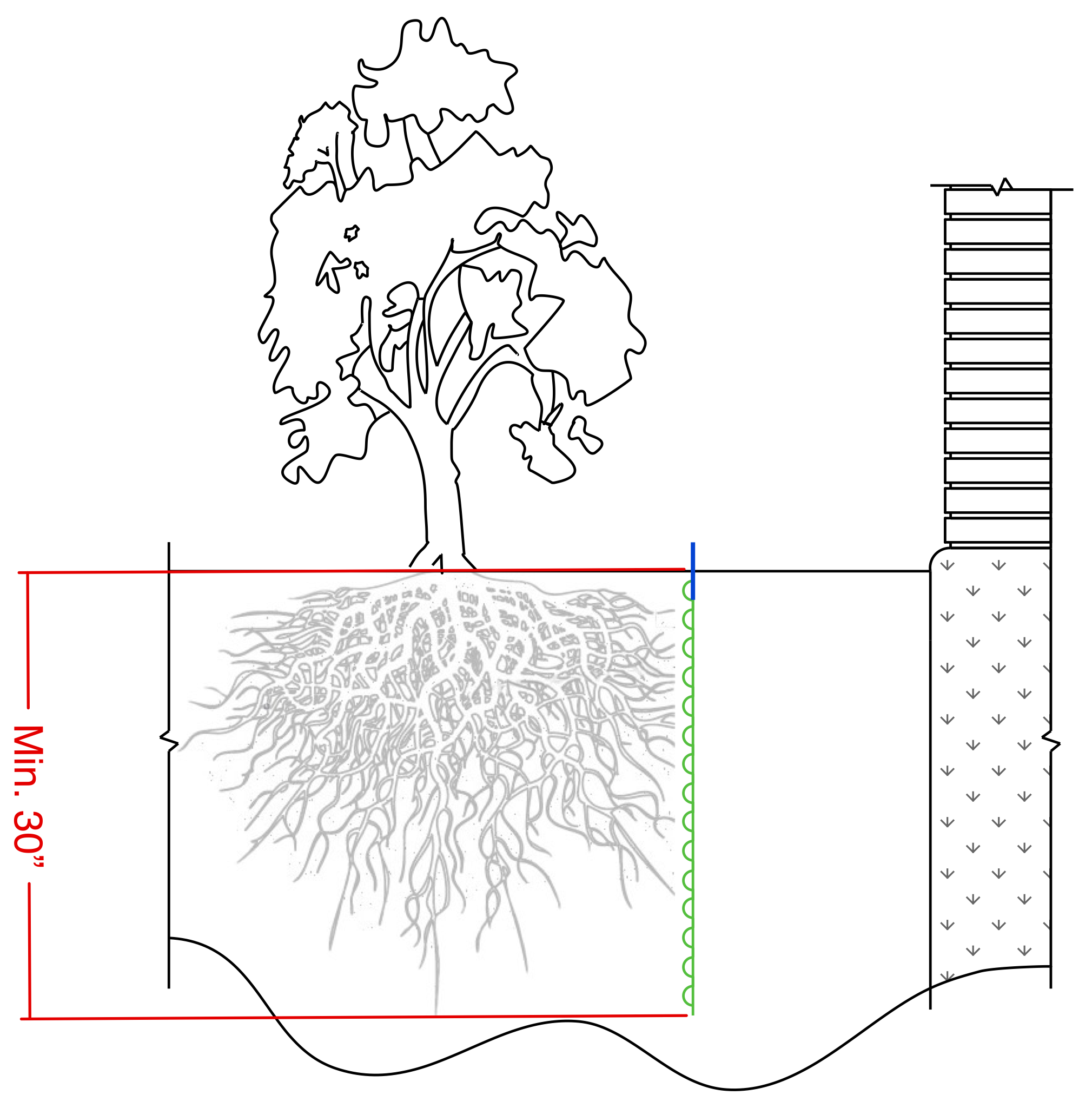The act of cutting off the roots of trees that are growing near a building and installing a barrier to prevent their reestablishment in the area where they are not desired is called installing a root barrier, a root wall, or root capping. The need for root barriers is related to the fact that expansive clay soil shrinks as it dries out. Any structure that expansive clay soil is supporting will move downward as the soil dries and shrinks. If the soil dries on one side of the structure and not the other, the soil shrinks where it has dried and remains expanded where it has not dried, causing the structure to experience differential settlement. Differential settlement can cause serious damage to a structure.
A root barrier is usually installed between concrete foundations or flatwork and adjacent trees within their mature height from the foundation and where there is expansive clay soil to prevent tree roots from consuming moisture from the soil under the area of concern (figure 1). The barriers are installed so that they intersect imaginary radial lines extending from the trunk of the tree to the edges of the foundation. Root barriers can prevent damage to flatwork concrete such as walks and drives or to concrete slab on grade foundations. In some cases it is possible that differential settlement that has occurred because of shrinking soil can be reversed. The soil under a structure will swell or expand as it becomes rehydrated and in doing so will lift the portion of the structure that has experienced differential settlement back to near the level of the structure where differential settlement has not occurred.

Figure 1
Root barriers can be made with any impermeable durable material that can withstand burial in soil for an extended period of time. Current information is that root barriers need to be installed to a depth of 30 inches minimum and they must extend above the surface of the soil enough to prevent roots from growing over the top (figure 2). There are root barrier materials that are permeable to moisture but will not allow roots to grow through them because of the chemical makeup of the barrier. It is our opinion that permeable root barriers should only be used under special conditions since the impermeable barriers hold moisture at the locations where it is desired.
Large trees with tap roots, such as pecan trees, may affect soil volume to a depth greater than the 30 inches indicated above. There is evidence that large pecan trees dry soil to the “water table” which causes it to shrink for a great depth. Where pecan trees have been removed to construct a building, the soil where the pecan tree was removed has swelled, causing significant damage to the interior of the structures. Pecan trees existing near a building have caused less differential movement during extended dry periods than other trees, probably because the tap root obtains a large amount of the trees’ water requirement from the “water bearing strata” usually found within 20 feet of the surface. Root barriers between pecan trees and similar type trees do have the effect of reducing shrinking of the soil on which a building rests.
When there is a desire to improve the out-of-levelness of a structure by rehydration of the supporting soil and there are large trees involved, there must be a root barrier installed. Releveling in this case can be accelerated by the installation of a foundation watering system . The watering system should be arranged to supply water uniformly around the foundation of a structure during extended dry periods. The moisture level of the soil should be maintained at an optimum condition so that there is no ponding water or overly saturated soil. This condition at present appears to be a subjective judgment on the part of the watering system operator. The moisture provided must be enough to prevent the soil from shrinking during extended dry periods, but free water should not be allowed to accumulate at the perimeter or underside of a foundation.
Installation of a root cap, root barrier, or root wall should be undertaken by a qualified tree expert if there is concern for the health of the tree whose roots are to be cut. Most tree experts in the Houston area have installed root walls and are familiar with their effect on trees. If a root barrier is installed between a tree and a structure where the tree is surrounded by large areas of flatwork concrete, or other buildings, there may be insufficient moisture for the tree to continue to live.
The installation of root barriers should always be implemented as part of a foundation maintenance program. General guidelines for care and maintenance for foundation on expansive clay soil can be found by reviewing our Foundation Care Document.


Recent Comments